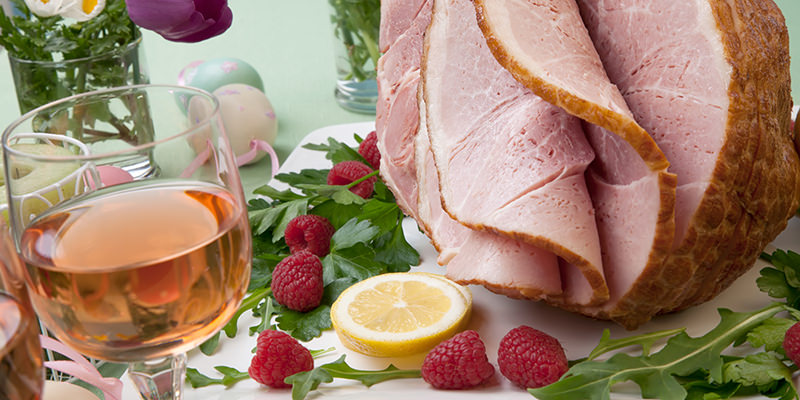Hams, and lambs, and ducks, oh my!
It’s officially Easter week, and after preemptively gorging on jelly beans and cream-filled eggs, it’s time to find wines for the real Easter feast. Whether it’s a swanky orphan’s brunch or the classic post-Church family extravaganza, fear not: even mint jelly has a vinous match!
From glazed spiral hams to duck à l’orange and everything in between, sweetness is the perennial difficulty when pairing wines with traditional Easter menus. With sugary entrées, acid and fruitiness in wine become key factors to a successful match.
Before delving into menu specifics, ask yourself this critical question: How much booze is appropriate at your Easter celebration? Will the meal follow a beer-fueled egg hunt, or is it a subdued gathering with the in-laws? Alcohol content is often unwisely disregarded when it comes to food and wine pairing. When choosing a wine for holiday celebrations, consider the likelihood of everything from domestic disputes to crazy Aunt Jane’s tendency to rope everyone into an embarrassing game of Twister.
Below, a guide to the ideal bottles for the gamut for traditional menus, and every type of Easter gathering this year.
On The Table: Ham
Easter’s most ubiquitous entrée, and the one food that may possibly rival cold turkey as a late night snack. The true beauty of roasted ham is in the sugary glaze that complements the high sodium content inherent in cured pork. Whether the glaze at your gathering is carefully concocted or comes from a mylar pouch, the ideal wine will interact with both the sweet and salty elements of the ham.
Whites with lots of stony minerality are a great choice here — fresh fruity flavors are an added bonus, and play a similar role to applesauce and other fruit accompaniments that have been served alongside pork for centuries. Dry or slightly sweet Rieslings, Pinot Gris, or Albariños from Spain work perfectly.
For a red-centric gathering, minerality takes a backseat to fruity flavors in finding a fantastic match for hams of all sorts. Berry-scented Grenaches, cool-climate Pinot Noirs (like those from Oregon, New Zealand, or Burgundy) or lively Austrian Zweigelts are great options. Beware of 15% ABV Grenache-based wines…unless you’re into that kind of party!
Bottles To Try:
Eyrie Vineyards 2014 Pinot Gris, Dundee Hills, Oregon
Orowines Kentia 2014 Albarino, Rias Baixas, Spain
Dashe 2014 “Les Enfants Terribles” Grenache, Sonoma, California
On The Table: Lamb
Roasting a whole animal in the yard à la My Big Fat Greek Wedding? Whole animal, leg, or chops, lamb and its herbaceous, often spicy accompaniments demand a wine that’s nuanced, and has enough earthy tones to mingle with the lamb’s flavorful yet delicate meat. Soft, medium-bodied reds and whites make fantastic combinations.
Southern Italian reds–like Nero d’Avola or aged Taurasi–and Merlots from Bordeaux or California are natural matches for richly roasted cuts of lamb, thanks to medium tannins that won’t overwhelm lamb and its traditional sides. For a lighter style, inexpensive Piedmontese reds like Dolcetto or Barbera work beautifully since they combine refreshing acid with mild tannins and a dash of earthy funk.
In the white camp, full-bodied wines with rich and nutty flavors compliment herbaceous lamb co-stars like mint jelly or rosemary spice rubs. Floral-scented Viogniers from the Rhône Valley or White Riojas are excellent options. Skin contact “orange” wines are also a great option (especially if you’re dining with the hipster, wine-geek crowd), since they contribute tannins similar to red wines, but with the fruity flavors of whites.
Bottles To Try:
DeForville 2014 Barbera d’Alba, Piedmont, Italy
Tami’ 2013 Nero D’Avola, Sicily, Italy
Lopez de Heredia 2002 Viña Tondonia Reserva, Rioja, Spain
On The Table: Duck
Let’s clarify: Duck is poultry prepared like red meat, so pairing “rules” go out the proverbial window on this one. Prepared with sweet glazes or spicy rubs, pairing wine with duck is all about fat — glorious, greasy, flavor-rich fat. Acid and tannin in wine both cut through fat, and make even the richest bites feel soft and light on the palate. This also means duck can meld with the racy, high acid whites and intensely bold, structured reds.
Red wines from Spain, especially smokey, oak-influenced Riojas are a natural match for duck, and delicious thanks to their spicy aromatics and rich cherry flavors. The same elements allow Pinot Noirs from Burgundy or Oregon to compliment duck beautifully.
Unctuous, off-dry whites like Gewürztraminer or Alsatian Rieslings offer a fantastic, lighter wine option with duck. Alongside the fatty meat, their sweetness becomes nearly imperceptible, and the combination of high acidity and bright citrus aromas helps meld all the flavors together.
Bottles To Try:
Roots “Klee” 2014 Pinot Noir, Willamette Valley, Oregon
F E Trimbach 2013 Gewurztraminer, Alsace, France
Beronia 2010 Reserva, Rioja, Spain
On The Table: Brunch
Brunch spreads often provide a pairing challenge because they offer a plethora of variety in food choices. Sparkling wines, the lightest whites, and gentle, fliratious reds are your best allies when confronting the buffet table. Little or no oak, and a lack of tannins allow these wines to agree with everything from eggs benedict to berry French toast, and smoked salmon-laden bagels. Wines like Muscadet, Portuguese Vinho Verde, and Gamay are excellent choices that are flexible, budget-friendly, and full of flavor.
Bottles To Try:
Broadbent 2014 Vinho Verde, Portugal
Luneau-Papin 2014 Muscadet, Loire, France
Meiomi 2015 Pinot Noir Nouveau, California
On The Table: Exhaustion
If you’ve decided to forgo Easter traditions in favor of Netflix and Doritos, or are simply drained from reading Easter pairing advice everywhere, fear not. Buy six bottles of sparkling wine — Champagne, Cava, or Prosecco — and you’re covered. Hosts love bubbly, all food pairs relatively well with it, and even $10 versions are incredibly palatable. Plus, they’ll last in the fridge longer than Peeps…if you can resist pairing them together.
Bottles To Try:
Nicolas Feuillate NV Brut, Champagne, France

